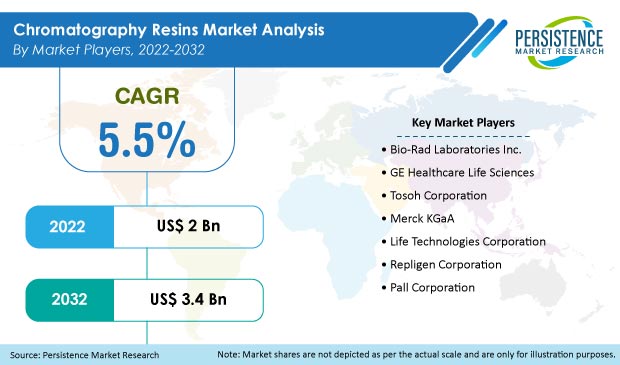Chromatography Resins Market Segmented By Natural, Synthetic, Inorganic type with Ion Exchange, Affinity, Hydrophobic Interaction, Size Exclusion Technique
Industry: Chemicals and Materials
Published Date: September-2022
Format: PPT*, PDF, EXCEL
Delivery Timelines: Contact Sales
Number of Pages: 250
Report ID: PMRREP4408
The value of the chromatography resins market is US$ 2 Bn in 2022 and is likely to grow to a size of US$ 3.4 Bn by 2032. The growth rate of the industry is predicted at a CAGR of 5.5% through 2032.
Natural resins are preferred and contribute more than 50% of the market share in 2022 owing to their production through natural resources leading to increased consumption.
|
Chromatography Resins Market Size (2022E) |
US$ 2 Bn |
|
Projected Sales of Chromatography Resins (2032F) |
US$ 3.4 Bn |
|
Global Market Growth Rate (2022-2032) |
5.5% CAGR |
|
Value Share of Pharmaceuticals & Biotechnology (2021A) |
88% |
Chromatography resins are used in the purification and separation of proteins and other bio-molecules in biotechnology, pharmaceutical, food manufacturing, and environmental analysis. Chromatography resins are of three types: Synthetic, natural, and inorganic media.
Natural polymers include agarose, cellulose, and dextran, among others, while synthetic resins include ion exchange resins. The natural and synthetic types are the preferred chromatography resins as compared to inorganic media.
Chromatography resins are used in affinity, mixed-mode, ion exchange, hydrophobic interaction, and size exclusion techniques. In terms of revenues, Protein A resins accounted for the highest share of the market. In technology terms, ion-exchange chromatography witnessed the highest consumption in the past few years. On the other hand, affinity chromatography resins held the key share by revenue largely due to the higher selling costs associated with affinity resins.
“Increasing Demand for Monoclonal Antibodies”
In recent years, there has been an increased demand for monoclonal antibodies across the globe due to the rising count of critical diseases. These healthcare issues have resulted in the increased sales of monoclonal antibodies, which has further driven the need for chromatography resins in the industry.
“Growing Use of Chromatography in Food Analytics”
Food analytics is serving as one of the pivotal factors driving the growth opportunities in this industry. Chromatography resins are used at an increased rate in nutritional and nutraceutical chemistry. These resins are used for the detection of food additives that can be a major issue in the food industry.
The biotechnology & pharmaceutical industries are also prominent end users of chromatography resins. There is also an increased need for chromatography resins for industrial applications; for example, environmental analysis and water treatment. In addition, the academic use of these resins in drug recovery and genetic engineering is likely to fuel the sales opportunities in the market.
However, despite various applications, stringent regulations related to the use of chromatography resins are predicted to serve as a noteworthy restraint on market growth.

Some of the key manufacturers of chromatography resins are Bio-Rad Laboratories Inc., GE Healthcare Life Sciences, Tosoh Corporation, Merck KGaA, Life Technologies Corporation, Repligen Corporation, and Pall Corporation.
Lower prices with higher productivity and new innovative products have been the key strategies for manufacturers to gain a competitive advantage in the market.
“North America Leads Due to Increased Demand from Biotechnology & Pharmaceutical Sectors”
Based on demand, North America is likely to lead the industry due to the increased requirement for chromatography resins from biotechnology and pharmaceutical applications. In addition, increased demand for these resins in the U.S. and growing health expenditure by the regional population are also predicted to have an indirect but positive impact on the growth of the market.
Europe is anticipated to hold a significant position in the global market. Food analytics and pharmaceuticals are the key applications for chromatography resins across the region. Italy, France, the U.K., and Germany are key regional markets that are projected to contribute substantially to growth opportunities in this regional market.
There is also a noticeable increase in the demand for chromatography resins across the South Asian and Pacific and East Asian regions. Countries such as India, South Korea, and China are leading the market owing to rapid growth in the pharmaceutical industry. In addition, the emergence of CROs and CMOs is a noticeable factor in these regions contributing to market expansion.
| Attribute | Details |
|---|---|
|
Forecast period |
2022-2032 |
|
Historical data available for |
2017-2021 |
|
Market analysis |
USD million for Value |
|
Key regions covered |
|
|
Key countries covered |
|
|
Key market segments covered |
|
|
Key companies profiled |
|
|
Report Coverage |
|
|
Customization & pricing |
Available upon request |
By Type:
By Technique:
By End Use:
By Region:
To know more about delivery timeline for this report Contact Sales

The global chromatography resins market is currently valued at US$ 2 Bn.
Demand for chromatography resins is likely to expand at a CAGR of 5.5% through 2032.
Natural chromatography resins contribute more than 50% of the total share of the industry.
Use of chromatography resins in pharmaceuticals & biotechnology accounts for 88% market share.